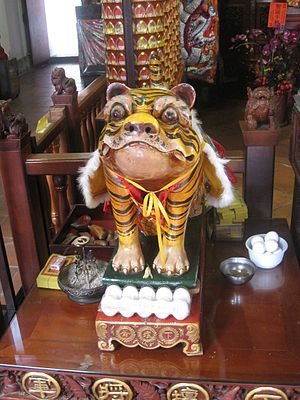Hu Jiang Jun

Hu Jiang Jun (Chinese: 虎將君; pinyin: Hǔjiàngjūn; lit. "general tiger") is a popular deity of Chinese mythology. Many Chinese temples have an altar for him, either a private altar or accompanying other deities. His altar is placed just above the floor, accompanied by Tu Di Gong or below the altar of Fu De Zheng Shen. In some shrines there will be one or more effigies of white or yellow tigers, in some cases the tiger is depicted either an actual tiger or is half-human. The white tiger god is called Bai Hu Jiang Jun (Hokkien=Pek Hou Ciang Kun) or "White general tiger".[1]
His other titles include Hu Jiang Gong (虎將公; "Lord general tiger"), Hu Ye (虎爺; lit. "Grandpa tiger"), or Di Hu (地虎; lit. "Earth tiger"). His Taoist title is Xia Tan Jiang Jun (Chinese: 下壇將軍; Hokkien: Ha Thua Jiong Kun; lit. "General of the lower altar").[1] In Anping[disambiguation needed] City, the altar for Hu Jiang Jun is placed high above the floor because the city is often flooded thus is called Tian Hu (天虎, lit. "Sky/heaven tiger").[2]
Chinese culture and Taoism regard the tiger as the king of the mountain or jungle and is often the animal mount of choice for some deities. His fierce nature is considered a symbol of authority and bravery.[3] Kids worship him in hope to grow strong and brave.[2]
Posture of the statue[edit]
According to Taoism, the posture of Hu Jiang Jun's statues have different meanings.[3]
| Number | Name | Posture | Meaning |
|---|---|---|---|
| 01 | Xia Tan Jiang Jun (下山開嘴) |
Downward with mouth open | The statue is placed under the altar of the main deity as the protector of the temple ground, groups, or priests. They are involved in ritual to help humans. |
| 02 | Xia Tan Jiang Jun (下山開嘴) |
Downward with mouth closed | The statue(s) is placed near Tu Di Gong's altar or just below the altar of Fu De Zheng Shen. They help the earth deities to inspect the area and report any incidents. People may ask him for protection from evil doers. |
| 03 | shàngshān huítóu kāi zuǐ (上山回頭開嘴) |
Upward with mouth open and looking backward | The statue represents a fierce tiger god that is full of hatred and may cause accidents. |
| 04 | shàngshān bìzuǐ (上山閉嘴) |
Upward with mouth open | The statue represents a happy and benevolent tiger god who gives his blessing without bias. |
| 05 | dūn zuò dà tóu hǔ yé (蹲坐大頭虎爺) |
Sits like a cat with huge head | A tame tiger god that overlooks over temple, altars, or households. |
Relation with another deities[edit]
Hu Jiang Jun usually have a relation and is displayed alongside another deities such as below.[3]
| Number | Name | Color | The deities who tame or connected |
|---|---|---|---|
| 01 | Bai Hu Jiang Jun Bi Hu Ye (碧虎爺) |
White | Zhang Daoling |
| 02 | Wu Hu Jiang Jun Hei Hu Ye (黑虎爺) |
Black | Zhao Gong Ming |
| 03 | Hu Jiang Jun Hu Ye (虎爺) |
Yellow with black strips | Tu Di Gong Sun Simiao Baosheng Dadi Xu Xun (許遜) |
Worship[edit]
Hu Jiang Jun is often worshipped to beseech spiritual protection, more than often he is called upon to subjugate evil demons. Offerings of raw meat are common offering items to place before his effigy.
References[edit]
- ↑ 1.0 1.1 (poanthian.webs.com) Houw Ciang Kun
- ↑ 2.0 2.1 Lo Cia Bio. "How Ciang Kun". Retrieved 25 October 2015.CS1 maint: Uses authors parameter (link)
- ↑ 3.0 3.1 3.2 Jave Wu (16 May 2009). "The Different Forms of Tiger Deities (虎爺/虎神的種類)". Retrieved 25 October 2015.CS1 maint: Uses authors parameter (link)
This article "Hu Jiang Jun" is from Wikipedia. The list of its authors can be seen in its historical. Articles copied from Draft Namespace on Wikipedia could be seen on the Draft Namespace of Wikipedia and not main one.
